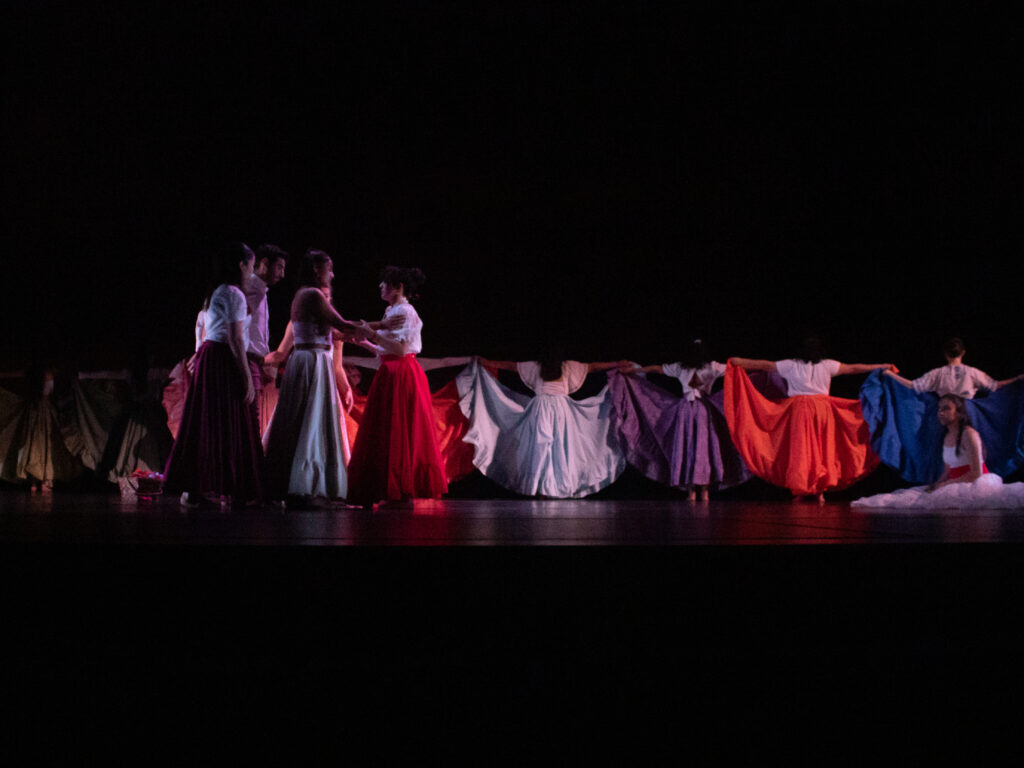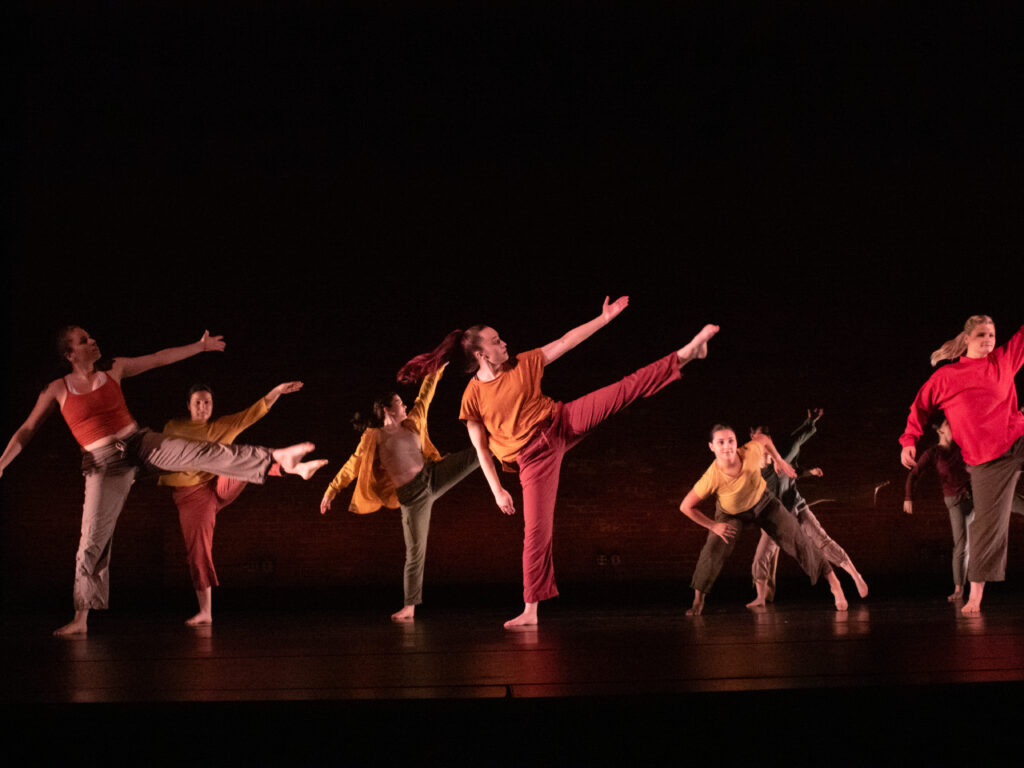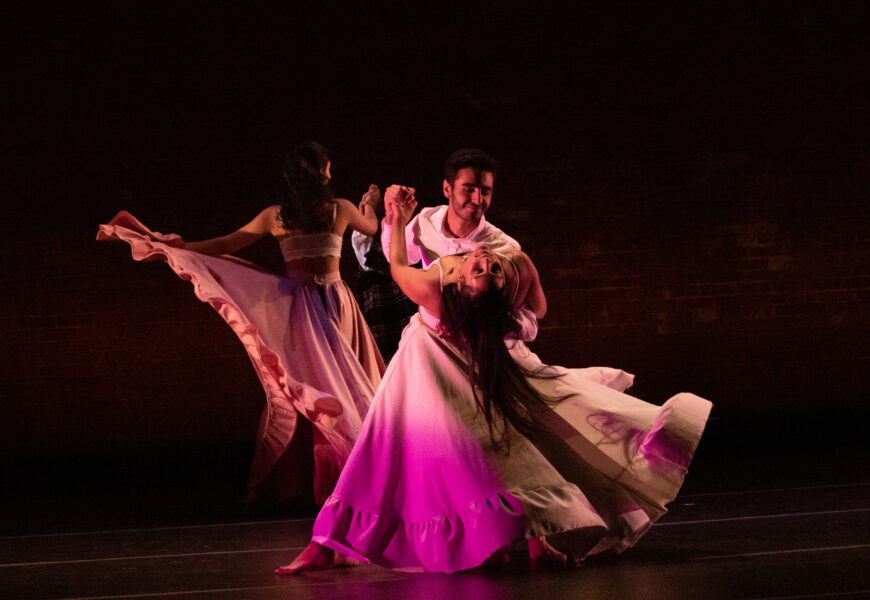Images courtesy of Sydney Bryan.
Time whisked by in Palmer Auditorium as the six senior dance majors successfully presented their capstone performance, “If We Could Turn Back Time,” performed in the newly renovated Palmer Auditorium on Apr. 21, 22, and 23. Seniors Mary Fitzgerald, Lucie Hdef, Juana Lopez Alvarez, Molly McGovern, Sam Siewertsen, and Elisabeth Wales developed original choreography in the Capstone course taught by Professor David Dorfman ‘81. Professor Rachel Boggia and Guest Artist Lauren Horn also debuted their works, rounding out the concert with a mix of movement genres, themes, and thrilling stage design. Students from Professor Shawn Hove’s production class facilitated the technical intricacies, and lighting designers David DeCarolis and Yichen Zhou joined from Yale University School of Drama to illuminate the stage.
Boggia’s “Canyon” opened the show with a cast comprised entirely of senior dance majors and minors. Dressed in layers of sheer, velvet, and metallic golden earth-toned costumes, created by Professor Heidi Henderson, the dancers regally commanded the space, floating and swirling like autumn leaves. Adjunct Instructor of Music Katie Kennedy sat downstage with her cello, playing live music with an accompanying recorded score. Boggia, the Associate Fellow for Curriculum for the Ammerman Center for Arts and Technology, and Professor Richard Schenk, the department musician, experimented with loop pedals and a solo cello, developing the rich score that enveloped the auditorium with a wash of warm tones.
Flourishing skirts and precise rhythmic footwork followed in Lopez Alvarez’s “Por la Fuerza nos Fuimos, Con Fuerza Seguiremo,” a lively piece honoring her Mexican heritage and immigrant history. Her cast was composed of BIPOC dancers with a wide range of experience and involvement in the dance department. The iconic skirts, sewn by Lopez Alvarez with assistance from myself, were personalized with fabric chosen by the cast. The dancers stood side by side and lifted their voluminous skirts to form a barrier that Izzy Sala ’24 struggled to cross, symbolizing the border many immigrants struggle to cross. Joyous dancing, including the four male dancers swishing squares of fabric and partnering the women, was permeated with more poignant tableaux and spoken word reminders of the painful system that “is not sensitive to emotions, community, and individuals.” She adds, “It’s also a memory of the loved ones we’ve left behind and how we continue to live our lives for them by planting the seeds they gave us in a new spot of soil. Adjusting and surviving.”

Lopez Alvarez’s dancers form a wall of skirts.
Up next, recordings of voicemails played on a dimly lit stage, ranging from enthusiastic birthday greetings to checking on your perpetually late friend to gushing about “the cutest girl” you saw at the club to friendships drifting apart. Fitzgerald’s “so… am I the drama?” explored communication, fluctuating relationships, and “all the drama” of life through the unexpected mundanity of voicemails. The sound score shifts from the recordings to a groovy tune, and dancers brought to life the moments described in the recorded messages. Some pairs shared a warm embrace while others drifted apart, exemplifying the rollercoaster of life’s dramas.
Just before intermission, “ALARMED.” dazzled the crowd with a flashy pink wake-up call. In typical McGovern style, she graced us with a high energy jazzy number with even higher legs. Dancers clad in hot-pink tank tops that matched McGovern’s signature hair embodied feminine strength and power. The dance began with machine-like movements, with dancers working as one unit to create large-scale patterns. When the beat dropped on the second section, the stage was flooded with vibrant rosy light, and the vibe shifted to dynamic, spirited energy that combined machine-like unity with bursts of individuality and partnership. With choreography that begins with Haley Michel ‘24 performing the most sumptuously slow push-up and ends with the group planking after a powerful, sharp unison phrase (and a spotlight on Michel reprising her push-up), McGovern accomplished her ferociously feminine goals.
After the break, 13 dancers walked across the stage, heads down, typing furiously on phones that illuminated their faces. This opening scene to Horn’s “Swipe Cycle” was the epitome of youth glued to their screens. Suddenly, an intense driving beat signals their bouncing bodies. A fast-paced, highly physical sequence ensued, followed by an equally rapid section that included forceful movement, rapid footwork, and impressive flexibility (looking at you Anna Zarzecki ’23). A climactic dance fight scene featured progressively more precarious stumbles onto the floor, notably from Sophie Barr ’23, whose jaw-dropping crash was a feat of immense control and fearlessness that made viewers audibly gasp. The frenzied beginning of the piece diminished as the dancer put down their phones for the first time, culminating in a calm, gentle section that revealed the natural beauty of humanity unattached to technology. However, this utopia didn’t last long as the dancers lined up, picked up their phones, and began frantically typing as the lights blacked out. The phone light lit their focused faces once more.
In another spectacular merging of art and technology, Hdef’s fusion of psychedelic visuals and movement inspired by personal experiences dancing at festivals set “Selfocracy dans la Rose” apart. Psytrance music and festivals, which “symbolize a place of security and self-reflection” for Hdef, helped shape the movement and visuals. The screen backdrop featured surrealist projections that felt deeply integrated with the movement as it drove the narrative. Hdef says, “This piece unfolds a conflicted father-daughter relationship,” demonstrated by the formidable partnership between herself and Moqu Alqudah ‘23, “with the ambiguity of hope for reconciliation and [her] sister’s cancer.” Her sister appeared in several moments in the abstract visual designs. The supporting cast, also including dancers of mixed backgrounds and experiences, formed large circles around the duo with pulsating and piercing motions, slowly rotating like a planetary system around Hdef’s sun.
Siewertsen’s “that’s how life goes…” juxtaposed Hdef’s rich visuals and layers of props, costume changes, and unique music with a stripped-down, movement-focused dance. The first half of the piece cut in and out with three different songs, with sections of silence in between. The strains of silence created tension with every pause and highlighted the dancers’ technically precise movements. The dance finally found release when the final R&B song played in full, and the dancers mixed groovy movement, unison moments, and intricate choreographic phrases. The dancers demonstrated a deep aptitude for Siewertsen’s distinctive easy-going yet rigorous movement style.

McGovern (center) in Siewertsen’s dance.
Swearing an oath has never been sexier. Wales’s politically and humorously charged grand finale, “This Union,” opened with recorded poetry written by Shawnia Yon ’24 and yours truly with accompanying solos in front of the blue velvet curtain. But as soon as the beat dropped and the curtain rose, the largest cast of the evening appeared. The all-women cast shouted phrases only ever said by male leaders in the US government, such as “in the state of this union.” But sprinkle in some theatrics from Lovisa Werner ‘22 calling “to my fellow citizens!” and Dale Lippincott ’23 interjecting with the most melodramatic “or should I say my fellow women!” and it becomes evident that Wales reimagines politics to be consciously humorous, powerful, and even a little sensual. A portion of the cast, featuring Bella Donatelli ‘24, more seriously explored the concept “wouldn’t it be nice…” and the solidarity between women in leadership.
A final senior slideshow of baby photos and memories from the past four years sealed the emotional ending to the show, with the seniors giving a final bow while jamming out to Cher’s “If I Could Turn Back Time.”









